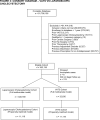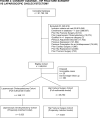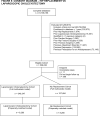New onset postoperative depression after major surgery: an analysis from a national claims database
- PMID: 37766788
- PMCID: PMC10520326
- DOI: 10.1016/j.bjao.2023.100223
New onset postoperative depression after major surgery: an analysis from a national claims database
Abstract
Background: Postoperative depression is not well characterised. We investigated the incidence of postoperative depression with the hypothesis that after controlling for confounders, new onset depression would vary significantly by surgical type.
Methods: We conducted a retrospective cohort study using the Optum Clinformatics Datamart. The primary outcome was new onset postoperative depression, defined by a new diagnosis of depression or new prescription for an antidepressant in the year after surgery using International Classification of Diseases (ICD) 9/10 codes and drug names. Adjustment for preoperative comorbidities and predictors of depression was with multivariable Cox regression and propensity score matching. Sensitivity analyses defining new onset depression as both a new diagnosis of depression and a new prescription for an antidepressant, or either outcome separately, were conducted.
Results: Data from 132 390 cardiac surgery, 12 538 thoracotomy, 32 630 video-assisted thoracoscopic surgery (VATS), 96 750 hip fracture surgery, 157 484 hip replacement, and 347 878 laparoscopic cholecystectomy patients from January 2004 to June 2021 were analysed. The incidence of new onset postoperative depression was 18.8% for hip fracture surgery, 16.1% for thoracotomy, 12.6% for cardiac surgery, 12.4% for VATS, 8.6% for laparoscopic cholecystectomy, and 6.8% for hip replacement. After multivariable adjustment, hip fracture surgery patients were most likely to develop new onset postoperative depression (hazard ratio [95% confidence interval]) 1.56 [1.45-1.68]), followed by thoracotomy (1.12 [1.03-1.22]), cardiac surgery (1.09 [1.04-1.12]), VATS (0.95 [0.90-1.00]), and hip replacement (0.55 [0.52-0.57]) compared with patients undergoing laparoscopic cholecystectomy (hazard ratio=1). Results from propensity score matched analyses and sensitivity analyses were similar.
Conclusions: The risk of postoperative depression differs by surgical type after controlling for preoperative characteristics.
Keywords: major surgery; national database; postoperative depression; propensity matching.
© 2023 Published by Elsevier Ltd on behalf of British Journal of Anaesthesia.
Figures






Similar articles
-
Favourable outcomes in patients with early-stage non-small-cell lung cancer operated on by video-assisted thoracoscopic surgery: a propensity score-matched analysis.Eur J Cardiothorac Surg. 2018 Sep 1;54(3):547-553. doi: 10.1093/ejcts/ezy101. Eur J Cardiothorac Surg. 2018. PMID: 29547899
-
Video-assisted thoracoscopic surgery yields better outcomes than thoracotomy for anatomical lung resection in Brazil: a propensity score-matching analysis using the Brazilian Society of Thoracic Surgery database.Eur J Cardiothorac Surg. 2018 May 1;53(5):993-998. doi: 10.1093/ejcts/ezx442. Eur J Cardiothorac Surg. 2018. PMID: 29253098
-
Video-assisted thoracoscopic surgery versus open lobectomy for primary non-small-cell lung cancer: a propensity-matched analysis of outcome from the European Society of Thoracic Surgeon database.Eur J Cardiothorac Surg. 2016 Feb;49(2):602-9. doi: 10.1093/ejcts/ezv154. Epub 2015 Apr 26. Eur J Cardiothorac Surg. 2016. PMID: 25913824
-
Comparison of the Short- and Long-term Outcomes of Video-assisted Thoracoscopic Surgery versus Open Thoracotomy Bronchial Sleeve Lobectomy for Central Lung Cancer: A Retrospective Propensity Score Matched Cohort Study.Ann Surg Oncol. 2020 Oct;27(11):4384-4393. doi: 10.1245/s10434-020-08805-y. Epub 2020 Jul 8. Ann Surg Oncol. 2020. PMID: 32642997
-
Decreased In-Hospital Mortality after Lobectomy Using Video-assisted Thoracoscopic Surgery Compared with Open Thoracotomy.Ann Am Thorac Soc. 2017 Feb;14(2):262-266. doi: 10.1513/AnnalsATS.201606-429OC. Ann Am Thorac Soc. 2017. PMID: 27779897
Cited by
-
New-Onset Depression Is Associated With Low Income and Adverse Arthroplasty-Related Complications.Cureus. 2025 Feb 19;17(2):e79311. doi: 10.7759/cureus.79311. eCollection 2025 Feb. Cureus. 2025. PMID: 40125106 Free PMC article.
-
Association of cholecystectomy with short-term and long-term risks of depression and suicide.Sci Rep. 2025 Feb 24;15(1):6557. doi: 10.1038/s41598-025-87523-5. Sci Rep. 2025. PMID: 39994212 Free PMC article.
-
Impact of postoperative depression and immune-inflammatory biomarkers on the prognosis of patients with esophageal cancer receiving minimally invasive esophagectomy: a retrospective cohort study based on a Chinese population.Front Immunol. 2025 Jun 6;16:1610267. doi: 10.3389/fimmu.2025.1610267. eCollection 2025. Front Immunol. 2025. PMID: 40547019 Free PMC article.
References
-
- World Health Organization . WHO; Geneva: 2017. Depression and other common mental disorders: global health estimates.
-
- Bisschop M.I., Kriegsman D.M., Deeg D.J., Beekman A.T., van Tilburg W. The longitudinal relation between chronic diseases and depression in older persons in the community: the Longitudinal Aging Study Amsterdam. J Clin Epidemiol. 2004;57:187–194. - PubMed
-
- Cole M.G., Dendukuri N. Risk factors for depression among elderly community subjects: a systematic review and meta-analysis. Am J Psychiatry. 2003;160:1147–1156. - PubMed
-
- Egede L.E. Major depression in individuals with chronic medical disorders: prevalence, correlates and association with health resource utilization, lost productivity and functional disability. Gen Hosp Psychiatry. 2007;29:409–416. - PubMed
-
- Lichtman J.H., Bigger J.T., Blumenthal J.A., et al. Depression and coronary heart disease. Circulation. 2008;118:1768–1775. - PubMed
LinkOut - more resources
Full Text Sources
Medical

